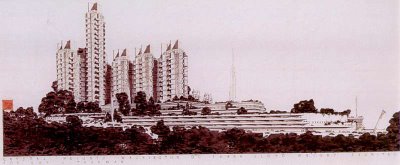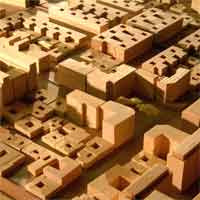It's been nearly twelve years since I first posted this piece, and sadly the question of "sprawl" versus "intensification" is still bloody topical. The most high-profile pillock promoting "out not up" is Chris Bloody Bishop, the housing minister, talking up the benefits of "greenfield" development over intensification. The latest high-profile pillock to promote building "up not out" is Ockham's Mark Todd, talking up Ockham's book of highly-marketed apartment building (and blithely unaware that increasing supply anywhere lowers prices everywhere). Like the little Mexican girl in the ad I ask, yet again, why not both?
The debate over affordable housing is already being framed as a facile debate between “sprawl” and “intensification”—a debate between those who wish to release (just a little) the planners’ ring-fences around NZ’s major cities to allow new homes on “greenfield” sections, versus those who insist we build with more intensity within the ring fence on so called “brownfield” sites.
The latter group characterise the former as being in favour of “sprawl”; the former characterise the latter as promoting the construction of the slums of tomorrow.
Both are right, and both are wrong.
What’s missing here is choice. In talking about about development on either “greenfield” or “brownfield” sites, both advocates insist that folk do things their way. They completely ignore the fact that people have the right to choose where and how they live, particularly if they own the place on which they choose to settle down.
Let people live where they wish to, as long as they bear the costs. And let those choices themselves—choices based on people’s own values for which they are prepared to pay the cost—organically reflect the way the city develops.
Ironically, it’s the very promoters of intensification, the planners themselves, who have done the most to make decent intensification more difficult. Here are just some examples of a few urban housing types that are enormously popular overseas, but could barely be even contemplated here…...
- Linked home units (e.g. 'sausage' blocks)
- Semi-detached housing units
- Four-storey walk-up apartments
- Multi-storey apartments with elevators
- Community housing, with shared courtyards, shared kitchen areas and the like
- Two, three, and four-storey terrace housing
- Courtyard housing, and courtyard clusters
- Mews housing
- Mixed-use four storey walk-ups
- innovative medium-density housing (such as Rotterdam's 'pole houses,' Frank Lloyd Wright's Suntop Homesand Crystal Heights apartments, San Francisco's Fulton Grove 'alley housing,' and Moshe Safdie's Habitat)
- Single family home on an eighth-of-an-acre section
 These are only some of the many, many housing types possible that may grace a city (some pictured below), and that’s not to mention some of the other innovative types that might be dreamed up (like Moshe Safdie’s ‘Habitat’ project at left, or Rotterdam’s ‘pole houses.’)
These are only some of the many, many housing types possible that may grace a city (some pictured below), and that’s not to mention some of the other innovative types that might be dreamed up (like Moshe Safdie’s ‘Habitat’ project at left, or Rotterdam’s ‘pole houses.’)
Now, with all these types of urban housing available, most of them enormously popular overseas (and some of them once very popular here), ask yourself how many of them a land-owner would be allowed to build on his typical bit of land in a typical NZ city...
If you guessed "not many," you'd be dead right.
 The answer (with rare exceptions) is that for most bits of land in most NZ suburbs, all of the housing types listed above that make the least use of scarce urban land are allowed, and all those that help increase the number of housing units that can comfortably work in a city -- and that are enormously popular overseas -- almost all of these urban housing types are disallowed.
The answer (with rare exceptions) is that for most bits of land in most NZ suburbs, all of the housing types listed above that make the least use of scarce urban land are allowed, and all those that help increase the number of housing units that can comfortably work in a city -- and that are enormously popular overseas -- almost all of these urban housing types are disallowed.
 Is this smart, do you think? People who complain about the number of single family homes that are built on eighth-of-an-acre sections right across NZ cities (which is mostly what NZ District Plans are written to protect) should direct their ire at those who ensure this is the only thing people are allowed to build: at the planners and the Resource Management Act that gives the planners their power.
Is this smart, do you think? People who complain about the number of single family homes that are built on eighth-of-an-acre sections right across NZ cities (which is mostly what NZ District Plans are written to protect) should direct their ire at those who ensure this is the only thing people are allowed to build: at the planners and the Resource Management Act that gives the planners their power.
District Plans drawn up by planners place enormous restrictions on what one can do one one's own land, restricting choice and trampling over property rights -- but it's been going on for so long and with so little protest that most of these restrictions and the "right" of planners to impose them are simply taken for granted. 
Planners have placed restrictions on the height of what you can build, on the setbacks of new buildings from the street and from boundaries, and most importantly restrictions are place on the density of new building -- on the number of housing units one may build on one's own land.
 It is the restrictions on density that exert the biggest stranglehold on our cities. At a density similar to some of the better parts of London for example, with which many NZers are familiar, the population of Auckland could be easily fitted on the ishthmus, with plenty of land left over for parks, and plenty of land left over outside the isthmus for decreased densities if people so wish.
It is the restrictions on density that exert the biggest stranglehold on our cities. At a density similar to some of the better parts of London for example, with which many NZers are familiar, the population of Auckland could be easily fitted on the ishthmus, with plenty of land left over for parks, and plenty of land left over outside the isthmus for decreased densities if people so wish.
Instead, the planners have ensured the city spreads slowly out into the country-side one relaxation of the ring-fence after another, creating the very "carpet sprawl" that so many supporters of the Resource Management Act claim they dislike, and removing the chance of genuine country living for those who do really desire it. 
In some parts of some NZ cities, even further restrictions have been placed on land, protecting the cold and archaic early twentieth-century housing that still disgraces so much of the early urban landscape. By which I mean those dark, damp, disgusting villas which need all the villa-ness removed in order to make them liveable, but which planners have made virtually impossible to touch.
Taking the power they’ve been given under the Resource Management Act and coupling it with the Utopian dreams handed down to them in Planning School, planners have almost single-handedly stuffed up our cities and restricted the supply of urban land, making building land even scarcer than it needs to be, and restricting the housing choices that New Zealanders are allowed to make to a one-size-fits-all bland-and-blander straitjacket, making urban space duller and even scarcer still.
Why do we give these people such power?

When there's just so much available, so many great housing types from which to choose, it just doesn't make any sense.
“Sprawl” or “intensification”? That’s a false dichotomy. I say let people be free to choose.
That’s the path to genuinely liveable cities, and to affordability.

1 comment:
Your eloquence on this topic is superb.
On a good note, I am hearing some very positive rumours from someone in the know about some good reforms of the RMA and related legislation coming through shortly. I know we’ve heard it before and it’s all come to nothing or gets even worse. But the detail of what I’m hearing now sounds really positive and sound, and not too hard to implement either.
Post a Comment